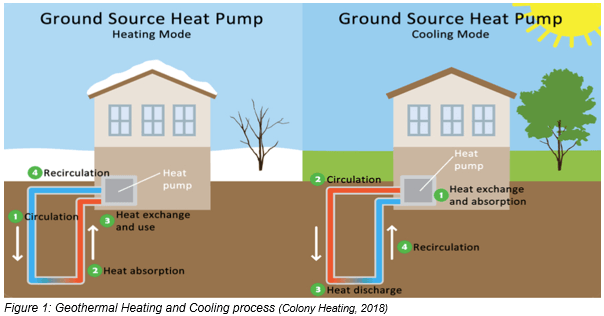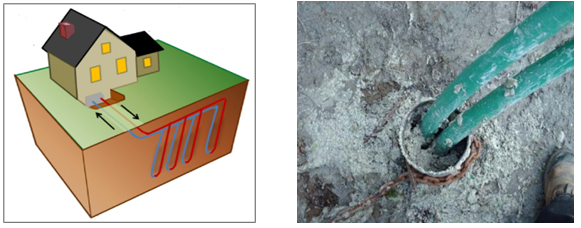Publications

By JP van Rensburg, June 2019
24th Dec, 2019
Imagine an energy source that is renewed daily, clean and can be found in your own backyard.
Geothermal energy systems use the temperature of the ground to either heat or cool the indoor environment. Making it a global means of heating and cooling as consumers become more environmentally aware. (Derek Whitfield, 2013)
Understanding Geothermal Systems
The shallow ground, at around 2m deep, maintains a temperature between 10°-17°C all year, which is far more constant than the air temperature above the surface. The deeper you go the more constant the temperature becomes. In most areas during winter the ground is warmer than the air above it and in summer the ground is cooler than the air, which means it can be used all year round. Ground and ground water heat pumps take advantage of these temperature differences to heat and cool the indoor environment. This is done by pumping water or refrigerant through a buried loop field of high-density polyethylene (HDPE) plastic tubing and returning it at warmer temperature in winter and cooler temperature in summer.

Horizontal vs Vertical System
The system can either be a horizontal or vertical loop field, depending on the land area available for the system and the depths at which the system would be most feasible.

Figure 2: Illustration of a horizontal u-shaped loop (www.halcoenergy.com) and Figure 3: Horizontal slinky loop system (Geothermal Heat Pumps, Pat Keegan & Amy Wheeless, 2016).

Figure 4: Illustration of a vertical u-shaped loop (greenhome.osu.edu) and Figure 5: Grouted vertical borehole (Earth Energy systems in Ontario, 2013).
Feasibility of Geothermal Systems in South Africa
Geothermal systems are still new in South Africa and the Southern Hemisphere in general as a result of the climate being milder than that of the Northern Hemisphere. Given the wide variety of climates we experience in South Africa, the feasibility of a geothermal system will differ from province to province.
The most notable development in South Africa with regards to Geothermal energy is the Hotel Verde, Cape Town. It has a geothermal loop field of a 100 boreholes at 65m deep, which supplies 304kW of cooling- and 364kW of heating capacity. The geothermal system in this case uses about 50% less electricity than a conventional HVAC (heating, ventilation and air conditioning) system (Andre Harms, 2017).

Figure 6: Hotel Verde, Cape Town (www.hotelverde.com) and Figure 7: Illustration of a geothermal system (www.sustainable.org.za)
Although initial capital outlay for geothermal systems are considerably higher than conventional HVAC systems, the savings in life cycle cost make up for it. Payback period is estimated at between 5 and 10 years, depending on the heating and cooling requirements of the project.(Ilan Solomons, 2013)
With South Africa’s ongoing electricity price hikes, the need for saving on electricity consumption is higher than ever. In March this year The National Energy Regulator of South Africa (NERSA) approved electricity hikes of 9.41%, 8.1% and 5.2% for the next three financial years (Tehillah Niselow and Lameez Omarjee, 2019). This adds to the 4.41% already approved in October 2018, meaning consumers will pay 27.12% more for their electricity by 2022 in an attempt to save the energy utility from its crippling debt. Making geothermal an attractive alternative to conventional systems when it comes to heating and cooling.
EARLIER POSTS